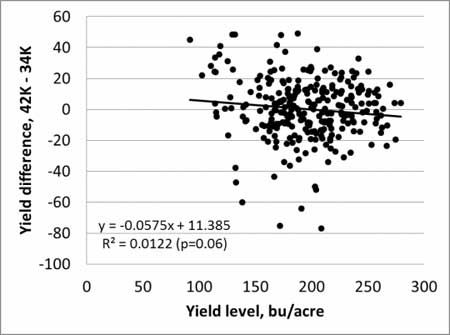Did We Miss The Boat On Corn Plant Population In 2014?
URBANA, ILL.
One of the speakers at the UI Agronomy Day at Urbana this past week
was quoted as saying that corn producers had not planted enough plants
this year to take advantage of the good growing conditions. The
assertion was that 45,000 plants would have been more appropriate than
32,000 plants. Most produces are planting more than 32,000 now on more
productive fields. But few are pushing populations into the mid-40,000
range, at least on a lot of acres. Did we all miss the boat by planting
“only” 35,000 or 36,000 seeds this year?
Fortunately, we have a lot of data to help answer this question.
Since 2011, we have been running trials at a dozen sites around Illinois
in which we plant 6 to 8 hybrids at a range of populations, including
planting rates of 34,000 and 42,000. Plant counts show that actual
stands are very close to planted populations. Counting each hybrid at
each site each year as a comparison, we have accumulated 277 comparisons
of 34,000 and 42,000 plants over the past three years.
Figure 1 shows all of these data, graphed to compare the yield change
when going from 34,000 to 42,000 plants against the average yield at
the two populations. On average the difference in yield between these
two populations was only about a tenth of a bushel, and there was no
indication that the response got larger as yield level increased; in
fact, the line drawn through the points shows slightly lower yield
differences as yield level increased.

Figure 1. Corn yield difference between 34,000 to 42,000
plants per acre in 277 comparisons in Illinois trials, 2011-2013.
At yield levels less than 150 bushels per acre, 42,000 plants yielded
9 bushels more than 34,000 plants, with a range of -62 to +48 bushels.
At yields above 250 bushels per acre, 42,000 plants yielded a half
bushel less than 34,000 plants, and the range was -24 to +24 bushels.
This reinforces what many of us know – that low-yielding conditions tend
to make yield less consistent, with more differences due to factors
like hybrid stress tolerance water-holding capacity within fields.
These data give no support to the idea that a corn crop planted at
populations in the mid-30,000 range is incapable of taking full
advantage of high-yielding conditions. The data also confirm that risks
of having populations too high for the conditions increases when we
don’t have conditions for high yields.
Because we don’t know what conditions will be at the beginning of the
season – the 2012 season started off great and would have been a “good”
season to raise populations at planting – it makes no sense to push
populations above 40,000 in hopes that we’ll get the weather to make
this pay off. In fact, the response of yield to population tends to be
fairly flat over the range of the lower to the upper 30,000s, regardless
of yield level or conditions. ∆
DR. EMERSON NAFZIGER: Research Education Center Coordinator, Professor, University of Illinois